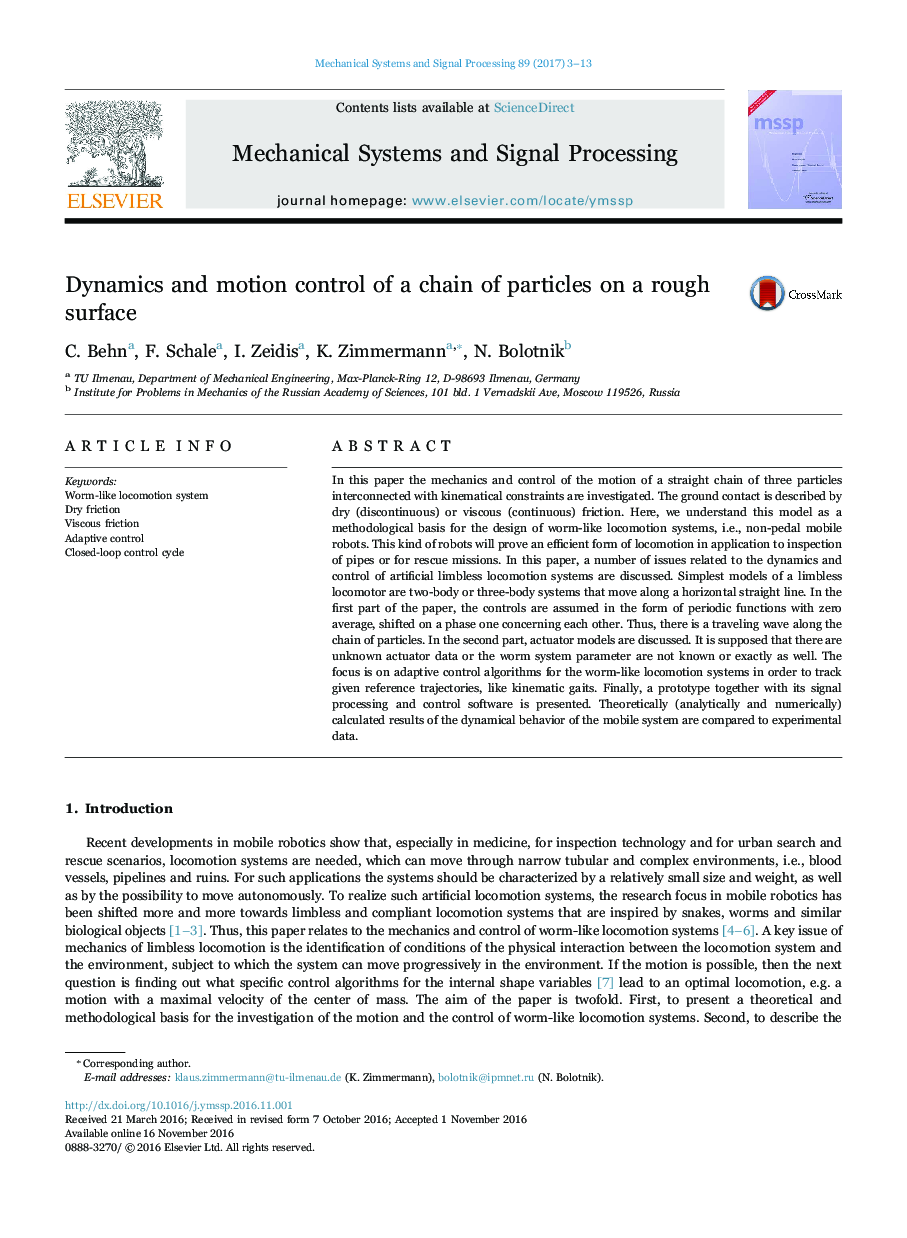| کد مقاله | کد نشریه | سال انتشار | مقاله انگلیسی | نسخه تمام متن |
|---|---|---|---|---|
| 4977115 | 1451846 | 2017 | 11 صفحه PDF | دانلود رایگان |
عنوان انگلیسی مقاله ISI
Dynamics and motion control of a chain of particles on a rough surface
ترجمه فارسی عنوان
دینامیک و کنترل حرکت زنجیره ای از ذرات در یک سطح خشن
دانلود مقاله + سفارش ترجمه
دانلود مقاله ISI انگلیسی
رایگان برای ایرانیان
کلمات کلیدی
سیستم حرکتی کرم مانند، اصطکاک خشک، اصطکاک چسبندگی کنترل انعطاف پذیر، چرخه کنترل حلقه بسته،
ترجمه چکیده
در این مقاله مکانیک و کنترل حرکت یک زنجیره مستقیم از سه ذره به هم پیوسته با محدودیت های حرکتی بررسی شده است. تماس زمین با اصطکاک خشک (فشرده) یا چسبناک (مداوم) توصیف می شود. در اینجا، ما این مدل را به عنوان مبنای روش شناختی برای طراحی سیستم های متحرک کرم مانند، یعنی ربات های متحرک بدون پدال، درک می کنیم. این نوع از روبات ها یک فرم موثر حرکت در استفاده از بازرسی لوله ها یا ماموریت های نجات است. در این مقاله، تعدادی از مسائل مربوط به دینامیک و کنترل سیستم های حرکتی مصنوعی بدون علامت مورد بحث قرار گرفته است. ساده ترین مدل های حرکتی بدون حرکتی سیستم های دو بدن یا سه بدن هستند که در امتداد یک خط افقی حرکت می کنند. در بخش اول مقاله، کنترل ها در قالب توابع دوره ای با میانگین صفر فرض می شوند و بر روی یک فاز اول مربوط به یکدیگر قرار می گیرند. بنابراین، موج حرکت در امتداد زنجیره ای از ذرات وجود دارد. در بخش دوم، مدل های محرک مورد بحث قرار گرفته است. فرض بر این است که داده های محرمانه ناشناخته وجود دارد یا پارامتر سیستم کرم شناخته نمی شود یا دقیقا همانند. تمرکز بر روی الگوریتم های کنترل انطباق برای سیستم های حرکتی کرم مانند برای پیگیری مسیرهای مرجع داده شده، مانند جاده های حرکتی است. در نهایت، یک نمونه اولیه همراه با نرم افزار پردازش و کنترل سیگنال ارائه شده است. از لحاظ تئوری (به صورت تحلیلی و عددی) محاسبه شده از رفتار دینامیکی سیستم تلفن همراه با داده های تجربی مقایسه شده است.
موضوعات مرتبط
مهندسی و علوم پایه
مهندسی کامپیوتر
پردازش سیگنال
چکیده انگلیسی
In this paper the mechanics and control of the motion of a straight chain of three particles interconnected with kinematical constraints are investigated. The ground contact is described by dry (discontinuous) or viscous (continuous) friction. Here, we understand this model as a methodological basis for the design of worm-like locomotion systems, i.e., non-pedal mobile robots. This kind of robots will prove an efficient form of locomotion in application to inspection of pipes or for rescue missions. In this paper, a number of issues related to the dynamics and control of artificial limbless locomotion systems are discussed. Simplest models of a limbless locomotor are two-body or three-body systems that move along a horizontal straight line. In the first part of the paper, the controls are assumed in the form of periodic functions with zero average, shifted on a phase one concerning each other. Thus, there is a traveling wave along the chain of particles. In the second part, actuator models are discussed. It is supposed that there are unknown actuator data or the worm system parameter are not known or exactly as well. The focus is on adaptive control algorithms for the worm-like locomotion systems in order to track given reference trajectories, like kinematic gaits. Finally, a prototype together with its signal processing and control software is presented. Theoretically (analytically and numerically) calculated results of the dynamical behavior of the mobile system are compared to experimental data.
ناشر
Database: Elsevier - ScienceDirect (ساینس دایرکت)
Journal: Mechanical Systems and Signal Processing - Volume 89, 15 May 2017, Pages 3-13
Journal: Mechanical Systems and Signal Processing - Volume 89, 15 May 2017, Pages 3-13
نویسندگان
C. Behn, F. Schale, I. Zeidis, K. Zimmermann, N. Bolotnik,
